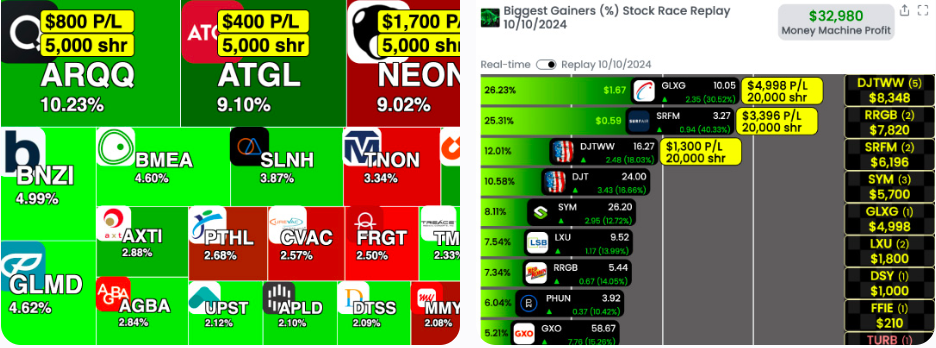20 Great News For Selecting AI Stock Trading Platform Sites
20 Great News For Selecting AI Stock Trading Platform Sites
Blog Article
Top 10 Ways To Evaluate The Integration And Compatibility Of Ai-Based Stock Forecasting And Trading Platforms
When evaluating AI trading platforms, compatibility and integration are crucial elements. A platform that seamlessly integrates with your existing tools such as systems, workflows, and processes can significantly enhance efficiency and productivity. Here are the top 10 suggestions for evaluating the compatibility and integration of these platforms.
1. Check Brokerage Integration
Ensure that your platform integrates seamlessly with the brokerage or trading service you prefer.
Trade execution: Verify whether the platform permits direct trade execution using the broker integrated.
Account synchronization: Check to determine if your system is capable of syncing accounts' balances, transactions and positions in real time.
2. Examine the availability of APIs
API access: Make sure the platform has an API (Application Programming Interface), which allows developers to develop customized tools and automate workflows.
API documentation: Check if the API is well-documented with clear examples and use cases.
Rate Limits: Examine the API's rate limits to confirm that they are appropriate and can handle your anticipated usage.
3. Evaluation of Third-Party Tools Integration
Popular Tools: Ensure that that the platform integrates with other software, like Google Sheets and Excel.
Export and import of data: Ensure that the platform allows easy export/import of data into and out of other tools.
Extensions or plugins: Check that your platform supports plugins or extensions. They can add additional functionality.
4. Test Compatibility with Operating Systems
Desktop compatibility: Ensure that the platform is compatible with your OS of choice (Windows, macOS or Linux).
Mobile compatibility: Check if there is a mobile application that works with iOS or Android.
Web-based Access: Check if you are able to access the platform through an internet browser to improve flexibility.
5. Examine Data Integration Capabilities
Data sources: Make sure whether the platform is integrated with a variety of data sources (e.g. market data providers or news feeds).
Data feeds that are real-time: Determine whether the platform allows real-time data integration to provide the most current analysis.
Historical data import: Check whether the platform supports the import of historical data for backtesting or analysis.
6. Check compatibility with cloud and on-premise
Cloud-based Platforms: The platform must be available anywhere there is an internet connection.
Solutions on-premise. If you are interested in on-premise deployments, check if your platform permits it.
Look into the hybrid model. It blends on-premise with cloud capabilities.
7. Verify Cross Platform Synchronization
Device synchronization. Ensure data and settings are synchronized across all platforms (desktops mobiles, tablets).
Verify that changes made to one device are immediately reflected on the other devices.
Check the platform to see whether it allows access to data or functions offline.
8. Check for compatibility between trading strategies
Trading strategies that are automated or algorithmic should be supported by the platform.
Custom indicators. Find out if the platform allows you to use technical indicators or scripts.
Strategy backtesting. Find out if the platform supports strategies for backtesting based on previous data.
9. Examine Security and Compliance
Data encryption: Verify that the platform is using encryption for data at stationary and while in transit.
Authentication : Verify that the platform has authentic methods that are safe (e.g. two-factor verification).
Compliance with regulations: Make sure that the platform meets relevant regulations (e.g. GDPR, FINRA, SEC).
10. Test Scalability Performance
Scalability - Make sure the platform you choose can accommodate your increasing requirements in terms of data and data.
Performance when under stress: Check if your platform responds well to high volatility market conditions.
Resource usage: Verify that the platform is using system resources efficiently (CPUs, memory, bandwidth).
Bonus Tips:
User feedback: Use user testimonials to evaluate the integration capabilities of the platform.
Trial period: Test the platform for free or download a demonstration to test how it works with your existing software and workflow.
Support for customers: Make sure the platform has robust support in case of integration problems.
These guidelines will help you assess the compatibility and integration of AI analysis and stock prediction platforms. This will ensure that they integrate seamlessly with your current platforms and boost your trading efficiency. Check out the best a knockout post about ai trading for blog tips including ai investment app, best ai stock, ai stock trading bot free, ai stock trading, best ai for trading, options ai, best ai stock, ai trade, ai stocks, using ai to trade stocks and more.
Top 10 Tips To Maintain And Update Ai Trading Platforms
In order to keep AI-driven platforms for stock predictions and trading secure and efficient It is vital that they be regularly updated. These are the top 10 suggestions to analyze their update and maintenance practices:
1. Updates will be made frequently
Tip: Check how often the platform updates (e.g. weekly or monthly, or quarterly).
Regular updates demonstrate active development of the product and an ability to react to market trends.
2. Transparency and Release Notes
Review the platform release notes to find out what changes or improvements are being made.
Transparent release notes show the platform's dedication to continual improvement.
3. AI Model Retraining Schedule
Tip: Ask how frequently the AI models are retrained with new data.
Why: Markets evolve, and models have to change to ensure accuracy and relevance.
4. Bug Fixes, Issue Resolution
Tips: Find out how quickly the platform responds to problems or bugs users have reported.
Reasons: Fast bug fixes can ensure the reliability of the platform and its functionality.
5. Security Updates
Tip Verify the platform's security protocols are regularly updated to protect trading and user data.
Why is it important: Security in financial platforms is essential to guard against breaches and fraud.
6. Integrating New Features
Tips: Check the latest features introduced by the platform (e.g. advanced analytics or data sources, etc.) in response to user feedback or market trends.
Why: The updates to feature features demonstrate creativity and responsiveness to the needs of users.
7. Backward Compatibility
Tip : Make sure updates do not disrupt functionality that is already in place or require significant configuration.
What is the reason: Backward compatibility enables a smooth transition.
8. Communication between the User and Maintenance Personnel
Tip: Find out how users are informed about planned maintenance or downtime.
Clare communication reduces disruptions and builds trust.
9. Performance Monitoring and Optimization
Make sure that your platform is constantly keeping track of performance metrics such as latency and accuracy and is constantly optimizing its systems.
The reason: Continuous optimization is necessary to ensure the platform's efficiency.
10. Conformity to Regulation Changes
TIP: Determine if the platform updates its policies and features to comply with new laws on data privacy or financial regulations. laws.
Why: To avoid legal risks and keep user trust, regulatory compliance is crucial.
Bonus Tip: User Feedback Integration
Make sure that the platform is actively incorporating user feedback into maintenance and updates. This indicates an attitude towards users and a firm determination to make improvements.
Through analyzing all these elements, it's possible to determine if the AI stock trading platform you select has been maintained properly. It should also be updated and adaptable to the changing dynamics of markets. Read the most popular get more information on best ai for stock trading for blog info including ai stock trader, how to use ai for stock trading, ai software stocks, free ai tool for stock market india, stocks ai, best ai trading platform, chart ai trading, stock predictor, free ai tool for stock market india, ai stock analysis and more.